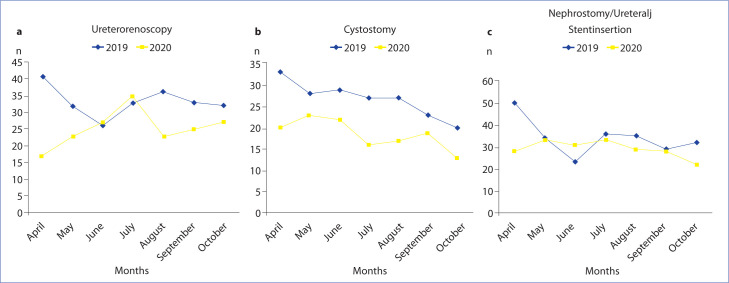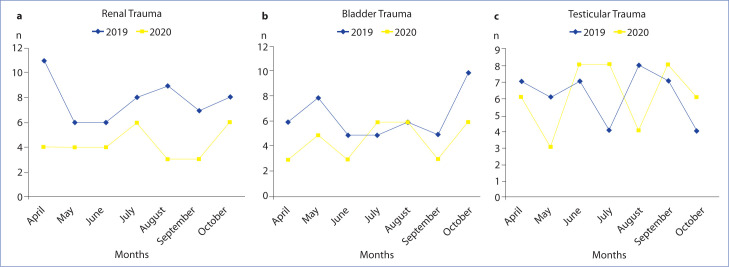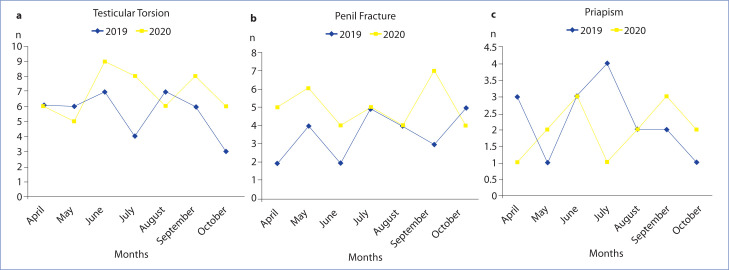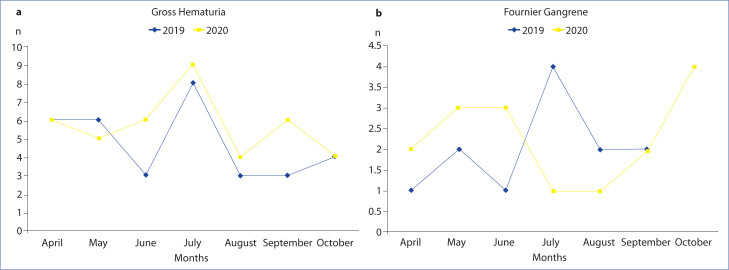Abstract
Objectives:
We aimed to reveal the change of urological emergencies during the COVID-19 pandemic compared to the same period of the previous year.
Methods:
The number of admissions to the emergency department (ED), admissions to the urology outpatient clinic, emergency urological consultations, and urological and emergency urological surgeries during the periods April-November-2019 and April-November-2020 were recorded. The data of the COVID-19 period were compared with the previous year.
Results:
While the number of admissions to the urological outpatient clinic was 160,447 during the COVID period, it was 351,809 during the non-COVID period. The number of admissions to the ED decreased from 3.2 million to 2.4. The number of admissions to the urology outpatient clinic significantly decreased by 54% during the pandemic (p=0.001). Percutaneous cystostomy performed due to acute urinary obstruction decreased by 27.96%, double J stent, nephrostomy decreased by 16.61%, and ureterorenoscopy decreased by 12.26%. Urogenital trauma also decreased. On the contrary, surgical procedures performed due to penile fracture, gross hematuria, Fournier gangrene, and testicular torsion increased.
Conclusion:
During the COVID-19 pandemic, a significant decrease was observed in non-COVID patients’ admissions to the emergency and urology department, and in urologic surgeries.
Keywords: COVID-19, pandemic, urological emergencies, urology
COVID-19, one of the largest pandemics in the world history, first appeared in China in December 2019. Then, it was declared a pandemic by the World Health Organization (WHO) in March 2020 when it spread to the whole world in a very short time.[1] Along with the beginning of the pandemic period, the COVID burden of the hospitals in our country increased significantly in a short time. This significant increase disrupted the daily operations of all clinics. As a result of problems such as the decrease in the number of outpatient clinics and the postponement of elective surgeries, non-COVID patients suffered from inability to receive treatment, which also caused some elective cases to turn into emergency cases in the next periods.
The pandemic also had significant effects on daily urology practice. In many hospitals, as result of the assignment of urologists, as well as all physicians, in pandemic services and outpatients clinics, urology clinics began to serve only emergency patients. There are also occasional difficulties in determining the urgency of non-COVID patients. There were also problems on the timely treatment of oncologic patients.
In particular, along with the effect of restrictions such as the curfew announced during the 1st months of the pandemic, there was a significant decrease in non-COVID patient admissions to hospitals, which is considered to be due to the fact that patients could not apply to hospitals by delaying their complaints for the fear of COVID-19.[2-4] We consider that emergency surgical procedures increased during the pandemic period as a result of this delay.
In our study, we aimed to reveal the change of emergency urological surgeries performed in 13 centers, where approximately 12 million people live, during the first 8 months of the pandemic period by comparing with the non-COVID period.
Methods
After the study was approved by Pamukkale University Ethical Committee dated January 5, 2021, and numbered E-60116787-020-4304, the data of 13 tertiary pandemic hospitals were included for our retrospectively designed study. The number of admissions to the emergency department (ED), the number of urological consultations requested from the ED, the number of patients examined in the urology clinic, the number of urological surgeries, and the number of emergency urological surgeries during the periods between April-November 2019 and April-November 2020 were recorded. Emergency endourological procedures for acute urinary tract obstruction, urosepsis, or medical treatment-resistant renal colic, and surgical operations for genitourinary trauma and acute scrotum were recorded. The period April-November 2019 was called as the non-COVID, the period April-November 2020 was called as the COVID period. The number of admissions to the ED, the number of urological consultations requested from the ED, the number of patients examined in the urology clinic, the number of urological surgeries, and the number of emergency urological surgeries were compared between the two periods.
Statistical Analysis
SPSS for Windows 24.0 package program (IBM Corp., Chicago, IL) was used for data analysis. Descriptive statistical methods (Number, Percentage, Average, Standard deviation) were used to evaluate the data. Shapiro–Wilk Test was used to show whether the numerical data were normally distributed. Student t-test was applied to numerical data with normal distribution, and Mann–Whitney U test was applied to numerical data without normal distribution. The results with p<0.05 were considered statistically significant.
Results
13 centers serving a population of approximately 12 million were included in the study. In the study, the urological workload, urological emergencies workload, and ED workload of the hospitals during the COVID period were analyzed together. While the number of patients admitted the urology outpatient clinic during the non-COVID period was 351,809, it was 160,447 during the COVID period. The number of admissions to the urology outpatient clinic significantly decreased by 54% (p=0.001). The number of admissions to the ED decreased from 3.2 million to 2.4 million. The number of emergency urological consultations and the number of urological surgeries and emergency urological surgeries also decreased during the COVID period compared to the previous year (Table 1).
Table 1.
2019 and 2020 workload indicator of 13 centers
|
2019
year (n) |
2020
year (n) |
Variation
(%) |
p | |
|---|---|---|---|---|
| Urological outpatient clinic visits (n) | 351809 | 160447 | –54.39 | 0.001 |
| Emergency outpatient visits (n) | 3253721 | 2455644 | –24.52 | 0.012 |
| Urological Emergency Consultations (n) | 4075 | 3623 | –11.09 | 0.059 |
| Urological surgery (Total) (n) | 27436 | 16729 | –39.20 | 0.001 |
| Emergency urologic surgery (n) | 1064 | 839 | –19.36 | 0.005 |
Among emergency urological surgery procedures, ureterorenoscopy performed in cases resistant to medical treatment decreased by 12.26% (Fig. 1a), and percutaneous cystostomy performed due to acute urinary obstruction decreased by 27.96% (Fig. 1b), A decrease of 16.61% was also observed in the number of nephrostomy/ureteral J stent insertion during the pandemic (Fig. 1c and Table 2). The number of patients intervened for priapism also decreased by 11.11%. The number of patients operated due to urogenital trauma (renal trauma, bladder trauma, and testicular trauma) decreased during the COVID period compared to the previous year (Fig. 2a-c). On the contrary, the number of surgical procedures performed due to testicular torsion (Fig. 3a) and penile fracture (Fig. 3b) increased during the COVID period, but 11.11% reduction for Priapism (Fig. 3c). The number of endoscopic procedures due to gross hematuria (Fig. 4a) increased by 25.71% and the number of debridement due to Fournier gangrene increased by 16.67% (Fig. 4b).
Figure 1. (a).
The number of emergency ureterorenoscopy performed during the COVID period and the previous year. (b) The number of emergency percutaneous cystostomy performed during the COVID period and the previous year. (c) The number of emergency nephrostomy/double j performed during the COVID period and the previous year.
Figure 2. (a).
The number of renal trauma in the COVID period and the previous year. (b) The number of bladder trauma in the COVID period and the previous year. (c) The number of testicular trauma in the COVID period and the previous year.
Figure 3. (a).
The number of testicular torsion in the COVID period and the previous year. (b) The number of priapism in the COVID period and the previous year. (c) The number of penile fracture in the COVID period and the previous year.
Figure 4. (a).
The number of endourological procedures due to gross hematuria during the COVID period and the previous year. (b) The number of surgeries for Fournier gangrene during the COVID period and the previous year.
Table 2.
The change of emergency urological surgeries between 2019 and 2020
|
2019
year (n) |
2020
year (n) |
Variation
(%) |
|
|---|---|---|---|
| Cystostomy (n) | 212 | 152 | –27.96 |
| Nephrostomy/Ureteral J stent insertion (n) |
277 | 231 | –16.61 |
| Ureterorenoscopy (n) | 261 | 193 | –12.26 |
| Renal trauma (n) | 54 | 35 | –35.19 |
| Testicular trauma (n) | 44 | 33 | –25 |
| Bladder trauma | 51 | 35 | –31.37 |
| Testicular torsion | 44 | 56 | +27.27 |
| Penile fracture | 30 | 38 | +26.66 |
| Priapism | 18 | 16 | –11.11 |
| Gross hematuria | 35 | 44 | +25.71 |
| Fournier gangrene | 18 | 21 | +16.67 |
Discussion
Our study revealed that there was a decrease in patients’ admissions to hospitals and the number of urological emergencies and emergency surgical interventions during the first 8 months of the pandemic in our country. Although there are similar studies in the literature, these studies generally covered a period of several months during the 1st months of the pandemic.[2,3] Our study, on the other hand, is the first study that discussed a slightly longer period of 8 months and compared it with the previous year.
We determined that there was a significant decrease in the number of patients admitted to the ED and urological outpatient clinic especially during the 1st months of the pandemic in our country. Similarly, Cicerello et al. and Grasso et al. also indicated that there was a decrease in the number of emergency urological surgeries during the pandemic, which is considered to be related to the fact that the 1st months of the pandemic were the period during which people’s fears and worries were most intense, and intensive restrictions announced.[2,3] We consider that this delay caused patients to present as an emergency case in the future. However, contrary to our expectations, we found that emergency surgical interventions decreased during the pandemic period. When it is considered that the centers included in our study were tertiary care services, we consider that it was related to the decrease in referral of urgent cases or patients’ admissions to local centers that were believed to have a lower burden of COVID. In the following months, as a result of the decrease in COVID cases and the removal of the restrictions, the number of admissions to hospitals gradually increased and became close to that in the non-COVID period.
In our country, elective surgeries were postponed along with the pandemic. Especially in hospitals providing pandemic services, only emergency and oncological cases were operated. In this case, there were sometimes discussions about which patient was an emergency and which surgical intervention was required. Guidelines and consensus reports were published on the approach to urological cases during the pandemic period by many study groups, especially the European Urology Association.[5-7] We consider that these guidelines and consensus reports are guiding for urologists in the management of emergency and oncological cases and provide convenience in decision making. However, urologists act in company with these guidelines, there were disruptions and delays in emergency and oncological cases due to the lack of services and especially intensive care in hospitals especially in the 1st months during which the pandemic was the most intense. We consider that it can be solved by separating a hospital as a “clean hospital” that will serve non-pandemic patients in every province in COVID and similar pandemic periods that may occur in the future.
In our study, we also found a decrease in genitourinary traumas, as in other traumas, as a result of daily life restrictions during the COVID period. The restrictions during the COVID period may be the reason for the decrease in emergency trauma admissions.[8] Unlike genitourinary trauma, we found an increase in penile fracture and testicular torsion cases. We consider that this increase in the incidence of penile fractures was due to the increase in the sexual activity of people along with the increase in the time they spent at home during the pandemic. In their study, Nelson et al. reported that testicular torsion increased surprisingly during the pandemic period.[9] We also found that there was an increase in the number of endourological interventions due to gross hematuria during the pandemic period. We consider that it was related to the fact that patients attempted to relieve their symptoms spontaneously at home and delayed their admission to the hospital. We consider that the increase in the number of Fournier’s gangrene debridement was due to the deterioration of blood glucose regulation, especially as a result of restricting the mobilization of diabetic patients, and the delayed admission to the hospital by delaying the symptoms.
Conclusion
The COVID-19 pandemic led to significant changes in emergency health-care services and daily urology practice. As a result of the changes in patient behaviors with fear and anxiety, the number of non-COVID emergency admissions, the number of emergency urological operations and the number of admissions to the urology outpatient clinic decreased. During the pandemic period, the urgency of urological patients should be evaluated well, especially oncological cases should be managed well, and there should not be delay in the treatment of patients.
Disclosures
Ethics Committee Approval: Pamukkale University January 5, 2021, E-60116787-020-4304.
Peer-review: Externally peer-reviewed.
Conflict of Interest: None declared.
Authorship Contributions: Consept – O.A., A.B.; Design – O.A., A.B., M.S.C., M.T.O., Y.O., S.C.; Supervision – O.A., I.E.A., A.Y.; Materials – O.A., E.K., M.Y., M.U.; Data collection and/or processing – O.A., A.B., M.S.C., K.T., I.E.A., A.Y., E.K., M.Y., S.C., Y.O., M.T.O., M.U., A.G., M.K.A., T.B., H.F.O.; Analysis and/or interpretation – O.A., A.B., A.G.; Literature search – O.A., A.B., M.T.O., M.K.A.; Writing – O.A., A.B., Y.O., S.C., M.T.O.; Critical review – O.A., T.B., H.F.O.
References
- 1.Sohrabi C, Alsafi Z, O'Neill N, Khan M, Kerwan A, Al-Jabir A, et al. World Health Organization declares global emergency: A review of the 2019 novel coronavirus (COVID-19). Int J Surg. 2020;76:71–6. doi: 10.1016/j.ijsu.2020.02.034. [DOI] [PMC free article] [PubMed] [Google Scholar]
- 2.Cicerello E, Mangano MS, Cova G, Zordani A. Urological emergency activities during COVID-19 pandemic: Our experience. Arch Ital Urol Androl. 2020:92. doi: 10.4081/aiua.2020.4.282. [DOI] [PubMed] [Google Scholar]
- 3.Grasso AAC, Massa G, Castelnuovo M. The impact of COVID-19 pandemic on urological emergencies: a multicenter experience on over 3,000 patients. Urol Int. 2021;105:17–20. doi: 10.1159/000511757. [DOI] [PubMed] [Google Scholar]
- 4.Citgez B, Yigit B, Capkinoglu E, Yetkin SG. Management of breast cancer during the COVID-19 pandemic. Sisli Etfal Hastan Tip Bul. 2020;54:132–5. doi: 10.14744/SEMB.2020.23326. [DOI] [PMC free article] [PubMed] [Google Scholar]
- 5.Ribal MJ, Cornford P, Briganti A, Knoll T, Gravas S, Babjuk M, et al. European Association of Urology Guidelines Office Rapid Reaction Group: An organisation-wide collaborative effort to adapt the european association of urology guidelines recommendations to the coronavirus disease 2019 era. Eur Urol. 2020;78:21–8. doi: 10.1016/j.eururo.2020.04.056. [DOI] [PMC free article] [PubMed] [Google Scholar]
- 6.Stensland KD, Morgan TM, Moinzadeh A, Lee CT, Briganti A, Catto JWF, et al. Considerations in the triage of urologic surgeries during the COVID-19 pandemic. Eur Urol. 2020;77:663–6. doi: 10.1016/j.eururo.2020.03.027. [DOI] [PMC free article] [PubMed] [Google Scholar]
- 7.Amparore D, Campi R, Checcucci E, Sessa F, Pecoraro A, Minervini A, et al. Forecasting the future of urology practice: a comprehensive review of the recommendations by International and European associations on priority procedures during the COVID-19 pandemic. Eur Urol Focus. 2020;6:1032–48. doi: 10.1016/j.euf.2020.05.007. [DOI] [PMC free article] [PubMed] [Google Scholar]
- 8.Giamello JD, Abram S, Bernardi S, Lauria G. The emergency department in the COVID-19 era. Who are we missing? Eur J Emerg Med. 2020;27:305–6. doi: 10.1097/MEJ.0000000000000718. [DOI] [PMC free article] [PubMed] [Google Scholar]
- 9.Nelson CP, Kurtz MP, Logvinenko T, Venna A, McNamara ER. Timing and outcomes of testicular torsion during the COVID-19 crisis. J Pediatr Urol. 2020;16:841. doi: 10.1016/j.jpurol.2020.10.021. [DOI] [PMC free article] [PubMed] [Google Scholar]






